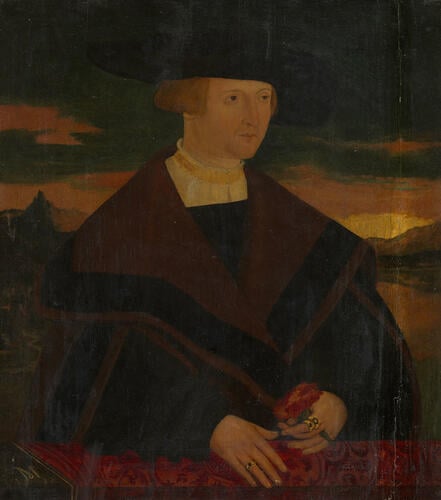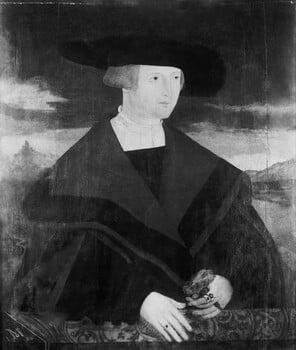-
1 of 253523 objects
Christoph Glockengiesser (1504-39) signed and dated 1530
Oil on panel | 57.2 x 49.9 x 0.6 cm (support, canvas/panel/stretcher external) | RCIN 403935
-
Ostendorfer is named after his birthplace, Ostendorf, near Meitingen in Swabia; he probably trained with Albrecht Altdorfer and served as court painter to the Elector Palatine, in Neumarkt. In 1519 he moved to Regensburg, where he remained for the rest of his life, becoming a protestant. During his later years this is evidence that he experienced poverty and increasingly depended on the charity of the local community.
This portrait is signed with a ‘Mo’ monogram on the ledge to the lower left, where the date 1530 also appears. On the rear of the panel there is a coat of arms and inscription in Gothic script, which reads (as far as it can be deciphered): NATUS ANNO DNI-MD-IIII- / GLOCKENGIESER PORTNER / FACTA.EST.IMAGO.HEC.ANNO.DNI. / MDXXX. / WILS. GOT.NIEMANDT.WENNDTS (‘Born AD 1504, Glockengiesser Portner; this image was made AD 1530; what God wills no man can change’). The sitter can be identified from this inscription and a print after this portrait (see BM Bp, 9. 217) as Christoph Glockengiesser (1504-39), a Regensburg Councillor.
The sitter is shown half-length, his hands placed on a parapet covered with a red brocade cloth, with a pink in his left hand. He wears a large hat, a brown coat over a black tunic, white shirt with gold collar and ruff. The portrait is set against a late evening landscape with mountains and river to the left, and cloudy sky with the last streams of daylight. The light of the setting sun to the right is created by the use of gold leaf. There may be some significance in showing so young a man in the sombre light of the fading day: perhaps an allusion to the transience of life. In which case the carnation flower – associated the Virgin Mary – is probably intended as a reminder of his faith.
Provenance
One of the group of early German works from the 77 paintings belonging to Prince Ludwig von Oettingen-Wallerstein (1791-1870), which were first offered to Prince Albert in 1847 as security for a loan and came into his possession by default (no 45 in Waagen’s catalogue of 1854); 25 of them were accepted by the National Gallery in 1863
-
Creator(s)
-
Medium and techniques
Oil on panel
Measurements
57.2 x 49.9 x 0.6 cm (support, canvas/panel/stretcher external)
58.5 x 51.3 x 3.4 cm (frame, external)
Alternative title(s)
Portrait of a Man

